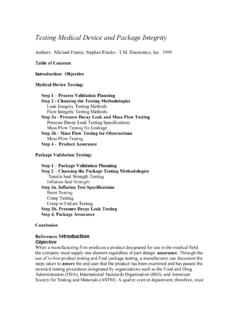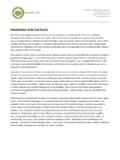Transcription of Leak, Flow and Package Testing 101 - Leak Testing Leak ...
1 Leak, Flow and Package Testing 101 Presented by TM Electronics, Inc. 2008 TM Electronics, Inc. Leak, Flow and Package Testing 101 Why is Testing important? Although Leak and Package Testing are different in their functional approach, the fundamental motivation for Testing is the same - to insure that material that is supposed to remain in a Package or product stays there, and that nothing in the outer environment that is not intended to get into the Package or product can enter.
2 You are taking this course because you are interested in basic leak, flow or Package Testing . Perhaps your product is designed to contain a material without losing any of the contents or to transfer a material or solution intact from one point to another. Perhaps you are introducing a new product that is itself enclosed in a completely sealed Package , sterile or otherwise, to protect the product from the world, or to protect the world from your product. Whatever issue you are facing, it has become apparent that Testing is important.
3 Leaks mean product failure. Seal or closure weakness may lead to leaks. A leak or seal weakness may lead to material leakage, environmental contamination, loss of sterility or component failure. In all cases, leaks mean waste of manufactured product, and leaks that are not found will surely lead to customer complaints! 2 2008 TM Electronics, Inc. Leak, Flow and Package Testing 101 Course Syllabus Term One: Device / Product Integrity Testing What is a leak?..5 Types of Leak .. 9 Pressure Decay Leak.
4 12 Mass Flow Testing and Flow Testing for 17 Statistics for Quality and Process 19 Term Two: Package Testing Introduction to ANSI/ 22 Seal Strength 24 Restraining Plate Package 27 Package Integrity Term Three: Non-Destructive Pressure/Vacuum Decay Chamber Testing for Sealed Products or packages Surrogate Chamber 35 Understanding your Test Designing your Test 37 Glossary of 42 Bibliography and References .. 45 2008 TM Electronics, Inc. Leak, Flow and Package Testing 101 3 First Term Overview: Device or Product Integrity Testing Whether you manufacture medical devices, auto parts, or other products, it is essential to provide assurance of product and flow Testing are a valuable way to enable your QC department to provide assurance of your product s or small leaks can be quantified using pressure decay and mass flow Testing , and flow Testing can also identify obstructions in flow-through parts.
5 The end result is that you, the manufacturer, will gain CONTROL over your manufacturing process, and QUALITYASSURANCE in the field. Leak Integrity Assurance Small leaks Large leaks Flow Integrity Assurance Occlusion Testing Mass Flow Test for Leakage Pressure Decay Leak Test Flow Integrity Testing Leak Integrity Testing Device or Product What is a Leak? In this section, we will discuss how leakage is measured and what is meant by Leak Rate. We will begin to look at the issue of determining the appropriate standard or specification for your particular product, and discuss the practical issues involving leakage including typical product leakage ( leak rate ), leak rate conversions and the price of no leaks.
6 Although important and fundamental in leak science, most information in this section relates to the identification and measurement of leaks; Package integrity Testing will be discussed in detail later in the course. 2008 TM Electronics, Inc. Leak, Flow and Package Testing 101 4 Unit 1: What is a Leak? Simply and directly, a leak is a hole or a path through which the Package contents may escape, or through which ambient materials from the environment may enter. There are holes in everything; the issue you face is to decide how large a hole must be to cause a failure, and where that hole is likely to be located.
7 Your answer to these questions will help to determine what kind of leak Testing is most appropriate for your product. There are two common methods of locating leaks: bubble Testing , and sniffer Testing with trace gas. We ll address these later in the class. A very important issue is the definition of the leakage or leak rate that must be found to avoid product failure, and this definition will vary according to your product and its circumstances. Remember that everything leaks, even if it is the permeation of gas molecules through a metal or plastic, or atoms leaking through a lead shield.
8 It s just a matter of time. The important point is that leakage is relative to a standard or specification. In order to define the specification or standard (how much leakage is too much leakage?), and indeed in order to measure leakage at all, we need to understand one basic relationship: Leakage (or Leak Rate) = V t where V is the volume of the medium exiting or entering and t is the time period during which you are measuring the change in volume. Leak Rate is therefore the volume of material (air, fluid etc.)
9 That escapes from a closed or sealed containment in a predetermined amount of time. You may see leak rate expressed in various units of measure, such as cc/min, cc/sec, or ft3/hr. The units will generally reflect whether you are measuring a relatively high or low leak rate; for example, leakage of air from a medical fluid container will be typically in the range of 1 x 10-3 cc/sec (quite small) but air leakage from a water pump may be in the moderately high range of 8-10 cc/min and still be considered an acceptable part based on its use and test specifications.
10 We will discuss the setting of test specifications later in this course. Note that some people will use a leak measure as a change in pressure over time (psi/sec, kPa/sec). These measures represent the result of the volume leakage rate for that specific application. However, unless the total volume of the part and measuring system are known, these measurements cannot be standardized against other instruments or measuring systems. Using volumetric or mass measurements provides the best approach to defining leakage in a test system.

